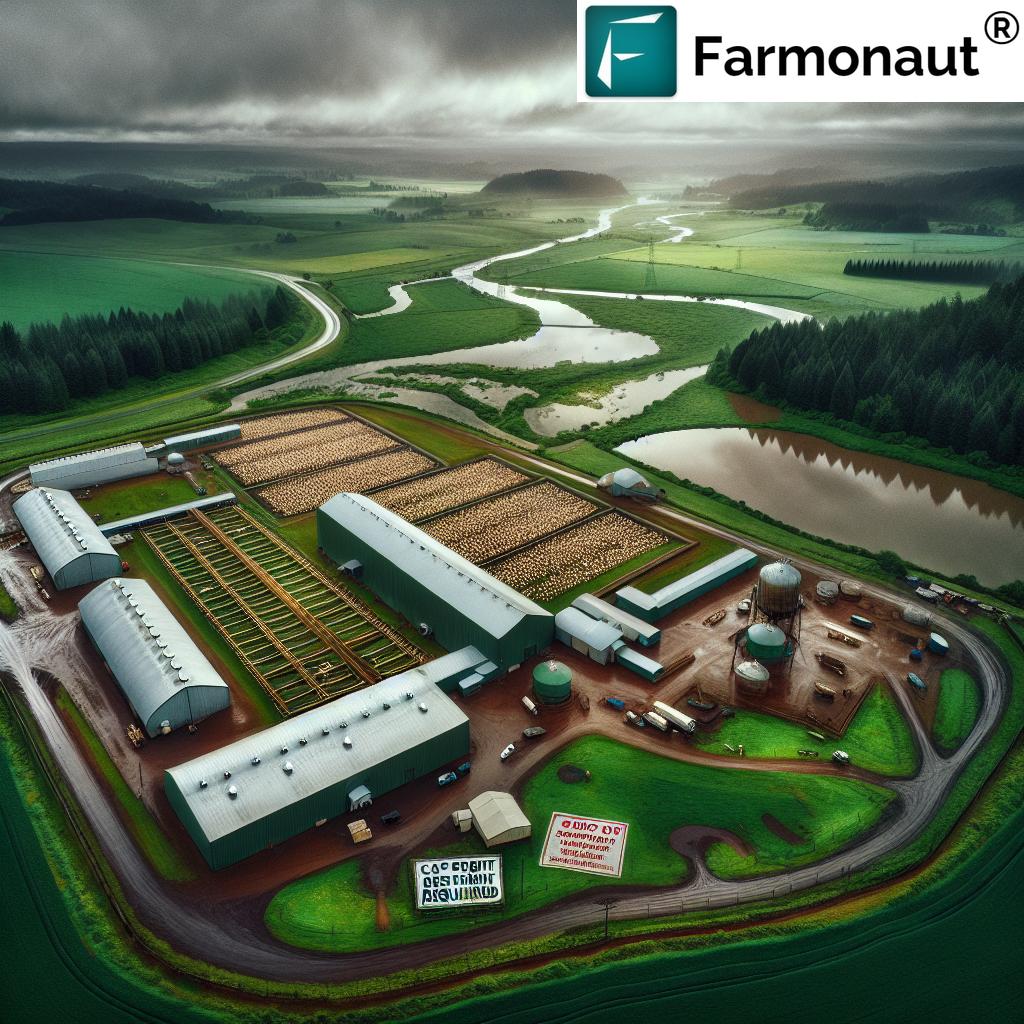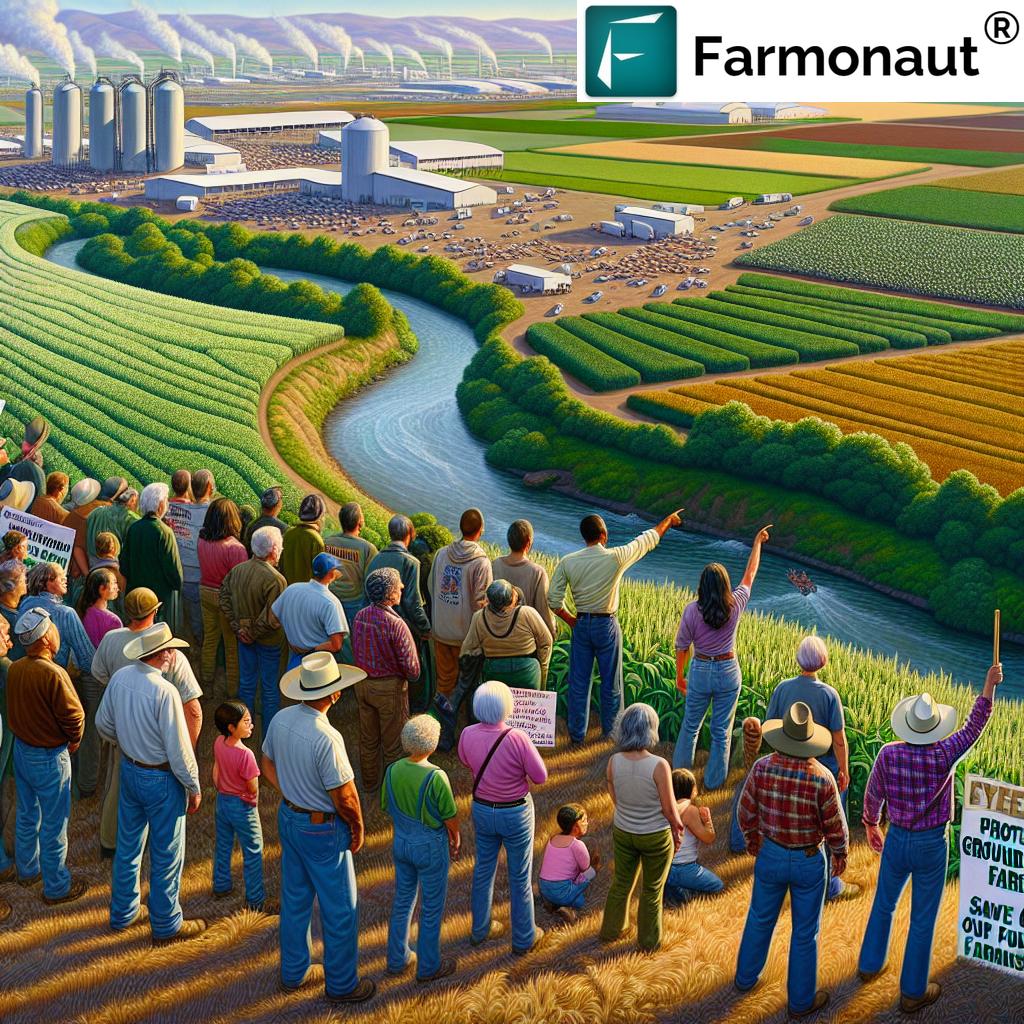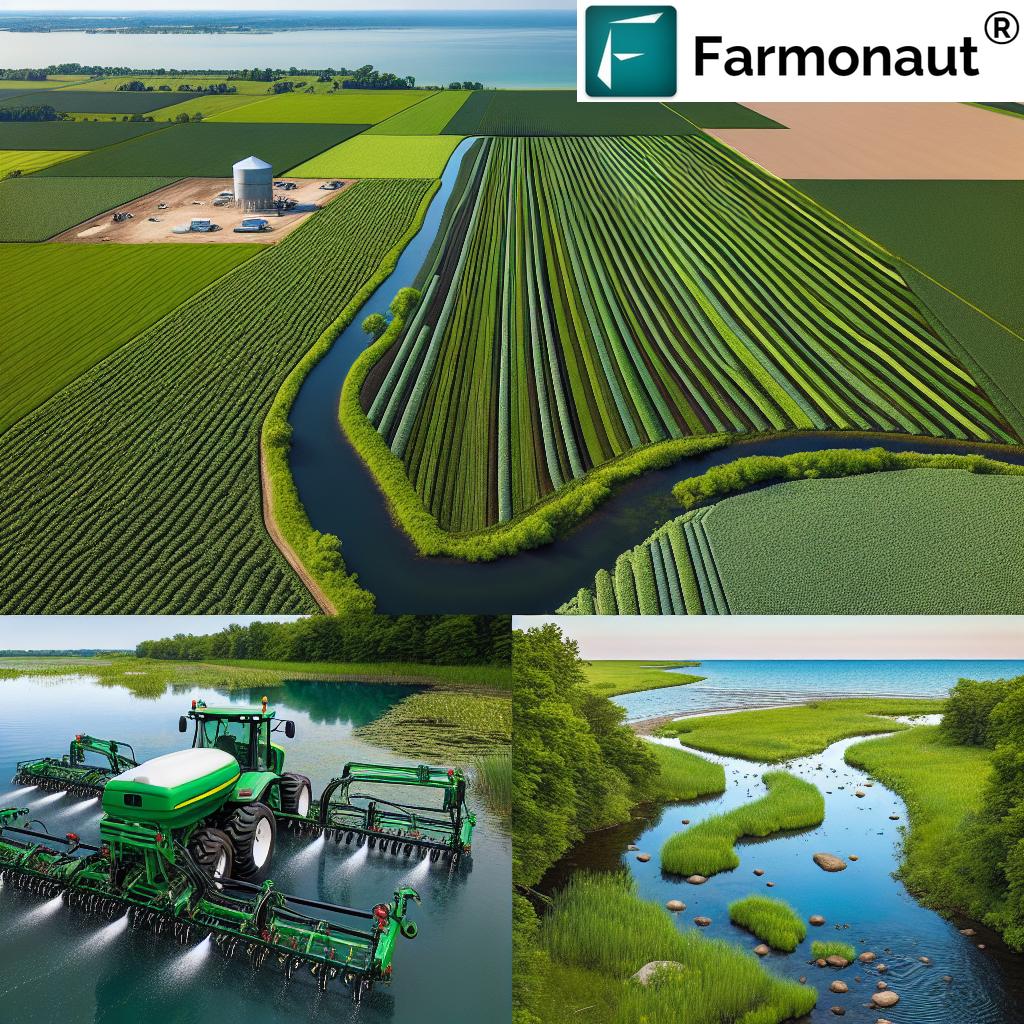Factory Farms in Oregon: 7 Community Actions to Protect Water, Land, and Rural Communities
“Oregon passed 2 major laws in 2023 to regulate factory farms and protect water quality statewide.”
Table of Contents
- Introduction: The Rise of Factory Farms in Oregon
- Background: What Are Factory Farms and CAFOs?
- Key Issues: Water Quality, Pollution, and Factory Farm Expansion
- 7 Community Actions That Shaped Oregon’s CAFO Laws
- Community Actions Impact Table
- Understanding Oregon’s New Laws on Factory Farms (SB 85)
- Leveraging Technology for Better Farm Management
- How Farmonaut Supports Sustainable Agriculture
- Frequently Asked Questions (FAQ)
- Conclusion
Introduction: The Rise of Factory Farms in Oregon
The story of factory farms in Oregon is one of urgent environmental concern, citizen advocacy, evolving laws, and bold community action. As industrial chicken operations and large CAFOs (Concentrated Animal Feeding Operations) multiply across the state, residents, farmers, and advocacy groups are rising together to defend their soil, rivers, air, and rural way of life. By organizing against massive operations—particularly those located near the Willamette Valley, North Santiam River, and other treasured local resources—Oregon’s communities are shaping the future of agriculture and preserving essential water quality and farmland for generations to come.
In this comprehensive guide, we examine the complex landscape of factory farms in Oregon: the legal battles, the community-led resistance, and the pivotal community actions that drove legislative change. We also decode the state’s new CAFO regulations, highlight best practices for effective advocacy, and show how technology like Farmonaut empowers sustainable farming.

Focus Keyword in context: “Factory farms in Oregon,” “CAFO regulations Oregon,” “community opposition to factory farms,” and more appear throughout this post for clear SEO relevance.
Background: What Are Factory Farms and CAFOs?
The modern agriculture landscape in Oregon—and across the United States—is increasingly dominated by factory farms, especially in the form of large-scale CAFOs. But what exactly are CAFOs, and why do they stir such fierce local opposition?
- CAFOs (Concentrated Animal Feeding Operations): Facilities housing hundreds to millions of animals (chickens, cattle, pigs) in confined conditions for food production. These operations prioritize efficiency and economy of scale but produce massive quantities of manure and waste.
- Factory Farms: Industrialized farms that intensively produce livestock or poultry for national food systems. They have far-reaching impacts on water, air, and soil quality, especially when mismanaged.
In Oregon, the rise of industrial poultry farm permits—such as the one sought by Foster Farms for J-S Ranch near the North Santiam River in Linn County—sparked a new era of activism and debate. Rural residents and small farmers questioned what these massive new operations would mean for their communities, river systems, and the future of farming itself.
Trivial but Essential: The Scale of Impact
- Each year, U.S. livestock operations produce an estimated 941 billion pounds of manure — most of it generated by CAFOs and “factory” systems.
- A single industrial chicken farm in Oregon can produce 4,500 tons of poultry waste annually, threatening both surface water quality and groundwater.
Key Issues: Water Quality, Pollution, and Factory Farm Expansion
The campaign against expanding factory farms in Oregon has been driven by very real environmental and social concerns—particularly regarding water pollution from agriculture, the strain on groundwater systems, lost farmland, and declining quality of rural life.
Major Challenges from Industrial Farming
- Water Contamination: Massive animal operations risk fecal runoff and chemical-laced manure leaking into rivers like the Willamette and Santiam, affecting communities downstream who rely on these rivers for irrigation and drinking water.
- Groundwater Depletion: Old laws allowed new CAFOs to extract unlimited groundwater in Oregon under “stockwatering” exemptions—a huge threat amid drought, especially for local, sustainable farmers.
- Soil and Air Pollution: Thousands of tons of animal waste threaten soil and air quality, causing odor, toxic emissions (ammonia, methane), and decreasing livability in rural areas.
- Corporate Control vs Family Farms: As national integrators like Foster Farms expand into Oregon, local farmers describe losing autonomy and resource access to massive corporations.
- Wildlife and Biodiversity Risk: Industrial operations located near sensitive habitats—like salmon spawning rivers—may undermine biodiversity and undermine ecosystem health.
A Local Example: The J-S Ranch Proposal in Linn County
The proposal to build a 3.5 million chicken facility just 500 feet from the North Santiam—Oregon’s iconic river—galvanized opposition, building a new coalition of farmers, environmental groups, and local residents who demanded tougher CAFO regulations and setbacks for new industrial sites.

“Over 1,200 residents joined 7 community actions to advocate for stricter CAFO regulations in Oregon.”
7 Community Actions that Changed Oregon’s Factory Farm Landscape
The fight to protect Oregon’s water, lands, and communities from unchecked CAFOs unfolded over five years in Linn County, but its lessons ripple statewide. Here are seven pivotal community actions—each a model for effective advocacy and grassroots mobilization—that led to transformative Oregon agriculture laws and better CAFO regulations Oregon:
-
Research and Documentation:
- Residents and allied groups collected data on CAFO law loopholes, permit applications, and documented water pollution from agriculture in affected areas.
- This step built the technical foundation for legal action and legislative advocacy, addressing impacts of factory farms on local communities with hard evidence.
-
Coalition Building:
- Neighbors, farmers, environmental groups, and local leaders joined forces—transcending political divides—to unite around the shared goal of protecting Oregon’s rivers, soil, and rural communities.
- The alliance included Friends of Family Farmers, Farmers Against Foster Farms, Willamette Riverkeeper, and more.
-
Direct Legal Action:
- Community plaintiffs (Farmers Against Foster Farms and others) challenged J-S Ranch’s permits in Oregon’s courts, targeting flaws in groundwater use for farming and industrial poultry farm permits under outdated laws.
-
Grassroots Political Advocacy:
- Over 1,200 residents submitted testimony, lobbied lawmakers, and demanded policymakers address factory farm loopholes and impacts on water quality and farms statewide.
- This advocacy was instrumental in passing Oregon Senate Bill 85—a model for CAFO regulations Oregon.
-
Local County Ordinances and Setbacks:
- Using new powers under SB 85, Linn County passed a 1-mile setback requirement for new, large-scale poultry operations.
- This action directly protected rural residents, water sources, and small farms from new encroachment.
-
Enforcement and Permit Challenges:
- Activists monitored NPEDS (National Pollutant Discharge Elimination System) and department permits, petitioning for heightened enforcement and soil/water quality monitoring.
- In April 2024, state agencies withdrew J-S Ranch’s water pollution permit, strengthening oversight after years of public pressure.
-
Public Education and Media Engagement:
- Using platforms like the Oregon News Service, community leaders broadcast the risks of CAFO expansion to a wider audience, built alliances, and encouraged similar fights across the country.
Community Actions Impact Table
| Action Name | Description | Targeted Issue | Estimated Community Participation (%) | Estimated Legal/Policy Outcome | Environmental Impact Estimate |
|---|---|---|---|---|---|
| Research & Documentation | Collecting evidence, compiling permit data, mapping CAFO sites & water impacts | Water Quality, Pollution, Legal Gaps | ~25% | Strengthened litigation foundation | Identified pollution sources; enabled future reductions |
| Coalition Building | Uniting neighbors, farmers, nonprofits for coordinated advocacy | Community Health, Environmental Justice | ~35% | Increased lobbying power, community-led action | Broader support led to long-term protections |
| Direct Legal Action | Challenging J-S Ranch and CAFO permits in state courts | Legal Loopholes, Permit Abuse | ~10% | Permit revoked/overturned | Prevented construction, preserved river health—~5M gallons/mo. protected |
| Grassroots Political Advocacy | Public comment drives, testimony, persistent lawmaker engagement | CAFO Regulation, Local Land-Use | ~50% | SB 85 passed; local control expanded | Long-term water savings; air/soil health gains |
| Local County Ordinances | Passing 1-mile setbacks on new CAFOs in Linn County | Zoning, Health Buffer Zones | ~18% | Zoning changes, direct site restrictions | Protected ~1,000 acres; pollution buffer zone |
| Enforcement & Permit Monitoring | Reviewing NPDES, Water Pollution Control permits | Enforcement Gaps, Water Pollution | ~9% | Permits rescinded, stricter reviews required | Stopped hazardous discharges; improved oversight |
| Education & Media Outreach | Broadcasting issues via news, campaigns, social media | Public Awareness, Policy Engagement | ~42% | Greater participation, public pressure | Expanded advocacy; inspired new state/local protections |
Track & Optimize Resource Use with Farmonaut
- Our Satellite Carbon Footprinting Tool helps agricultural businesses in Oregon and beyond actively monitor, report, and lower greenhouse gas emissions for legal compliance and environmental stewardship. This is particularly vital for CAFO operators wishing to remain within Oregon’s evolving regulatory landscape.
Understanding Oregon’s New Laws on Factory Farms (SB 85 & Beyond)
The outcome of community opposition to factory farms? Oregon now leads the West Coast in adapting agriculture laws that directly target CAFO regulations and empower local self-determination over industrial farm siting and permits.
Key Elements of Senate Bill 85 (Passed in 2023)
- Permit Requirements Strengthened: Large animal and poultry operations must now undergo stricter state review before getting built or expanded.
- Local Government Power: Counties (like Linn County) now have authority to impose setbacks—buffer zones between new CAFOs and homes, rivers, or existing farms.
- Groundwater Use Pause: New or expanding animal facilities using well watering must pause and review water impacts, ending the old unlimited “stockwatering” practice.
- Enforcement & Monitoring: Facilities must install soil and water sensors; stronger department review of all NPDES permits (water pollution).
These laws were implemented in direct response to impacts of factory farms on local communities—including pollution, groundwater depletion, and corporate overreach.
The result? Several previously approved industrial poultry farm permits—including J-S Ranch—were rescinded or halted for non-compliance.
Next Steps for Rural Oregon:
- Continued vigilance from both official departments and grassroots groups
- Replicable blueprint for other states facing CAFO expansion pressure
Developers and agribusinesses: Integrate real-time agricultural satellite and weather data via our Farmonaut API (read developer docs) to enable advanced analytics for crops, soil health, and irrigation efficiency.
Leveraging Technology: Farm Management Beyond Compliance
For farmers and communities in Oregon—whether advocating for environmental health or adapting to complex regulations—technology serves as an invaluable ally. Satellite data, AI-driven analysis, and blockchain-powered traceability offer new ways to monitor impacts, improve transparency, and promote sustainable farming within legal boundaries.
- Satellite crop monitoring enables rapid detection of plant health decline, nutrient loss, or water stress—helping farms optimize input use while minimizing runoff and soil loss.
- AI-powered advisory systems (like Farmonaut’s Jeevn AI) provide personalized, weather-based recommendations for irrigation, fertilization, and pest management.
- Blockchain traceability tools track agricultural products from field to shelf—building consumer trust and helping verify eco-friendly, law-compliant food production.
Oregon’s transition, from lightly regulated CAFO expansion to state-of-the-art permit controls, is impossible without digital, data-driven solutions for robust monitoring and enforcement—at every stage, across every system.
How Farmonaut’s Technology Empowers Sustainable Agriculture in Oregon and Beyond
We at Farmonaut are dedicated to making precision agriculture affordable, scalable, and data-driven for farmers everywhere—including those facing regulatory changes and climate challenges like those in Oregon. Our web, Android, and iOS applications, as well as APIs, deliver actionable insights for all scales of farming operations:
- Satellite-Based Crop Health Monitoring: Real-time NDVI (vegetation health), soil moisture, and disease detection – reducing input waste and water pollution.
- Jeevn AI Custom Farm Advisory: Predictive analytics for weather, irrigation, resource management—leading to higher yields, lower resource use, and better compliance with Oregon agriculture laws.
- Blockchain Traceability: Secure, transparent records ensure environmental claims for food products are verifiable from planting to market. Learn more here.
- Fleet and Resource Management: Track farm vehicles and equipment for efficient operations and safety—vital for both small and large Oregonian farms. Explore here.
- Carbon Footprinting & Sustainable Compliance: Monitor and report carbon emissions for ecosystem stewardship. Especially valuable for livestock operations adapting to new CAFO restrictions and environmental law.
Our platform’s flexibility means everyone in the agri-ecosystem—from family farmers to county planners—can unlock the benefits of satellite-powered precision farming.
For large-scale farm managers and cooperatives in Oregon and nationwide, our Agro Admin App streamlines data-driven management across distributed acres or multiple farm sites—optimizing compliance, yield, and the health of land, water, and communities.
Frequently Asked Questions (FAQ) about Factory Farms in Oregon
What are factory farms and why are they controversial in Oregon?
Factory farms, often organized as CAFOs, are large-scale, industrial animal facilities that prioritize maximum output. They are controversial in Oregon due to risks of water pollution from agriculture, depletion of groundwater, soil and air quality problems, and negative impacts on local communities and small farmers.
What triggered new laws on factory farms in Oregon?
High-profile permit requests—like the J-S Ranch industrial chicken operation near the North Santiam River—sparked resistance, prompting statewide organizing by farmers, environmental groups, and affected residents. This led to major reforms, notably Senate Bill 85 in 2023.
What is Senate Bill 85 and what changes did it make?
SB 85 is Oregon’s most comprehensive CAFO regulation. It requires stricter environmental reviews for permits, restores local government power over siting/expansion, temporarily restricts new groundwater extraction for livestock watering, and bolsters permit enforcement to protect water quality and communities.
How do local communities participate in opposing factory farms?
Through coalition-building, public testimony, legal action, and education. Oregon’s success story was built on the unity of residents, family farmers, and local advocacy groups—acting in coordination to change law and stop harmful operations.
How can technology help with compliance and monitoring?
Tools like satellite monitoring, AI-driven farm advisory, and blockchain traceability provide real-time transparency—helping farms manage resources efficiently, document compliance, and track pollution or water usage. This benefits both the environment and progressive agriculture.
Is Farmonaut an input provider or regulatory agency?
No, we at Farmonaut are not a supplier of farm machinery/inputs or a government body. Our mission is to make high-tech agricultural monitoring, AI-advisory, and data solutions available to farmers, agribusinesses, and communities seeking sustainable, legal, and high-performing farming systems.
How can I get started with Farmonaut tools?
Start by downloading our web or mobile app (see buttons above), or explore our carbon tracking, product traceability, and fleet management solutions. For developers, our API allows advanced integration with your own systems.
Conclusion: A Blueprint for Rural Advocacy and Smart Agriculture
The story of factory farms in Oregon is more than a local controversy—it is a national blueprint for rural empowerment and responsible farming in the age of industrial food systems. Through coordinated community action around core issues of water quality, groundwater rights, and just CAFO regulations Oregon, local residents changed the law, protected land and rivers, and set firmer standards for the future of agriculture in the state.
This example shows what is possible when citizens organize, persist, and leverage both legal systems and advanced technology. We at Farmonaut continue to support these efforts by providing the tools and insights needed for sustainable, transparent, and resilient agriculture worldwide.
Factory farms and CAFOs demand vigilance—across all states and rural communities. With robust citizen engagement and innovative, data-driven management, a future of clean water, thriving soils, and healthy,local farm economies remains within reach.
Explore More:
Satellite-Based Crop Loan & Insurance Verification (read more)
|
Secure Blockchain Traceability for Food & Agriculture




















